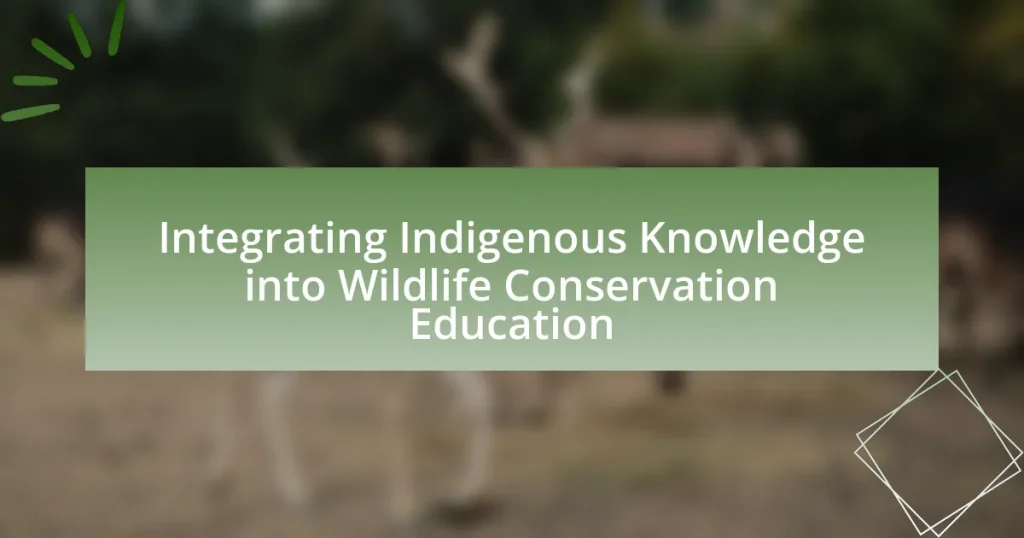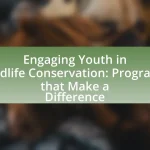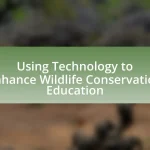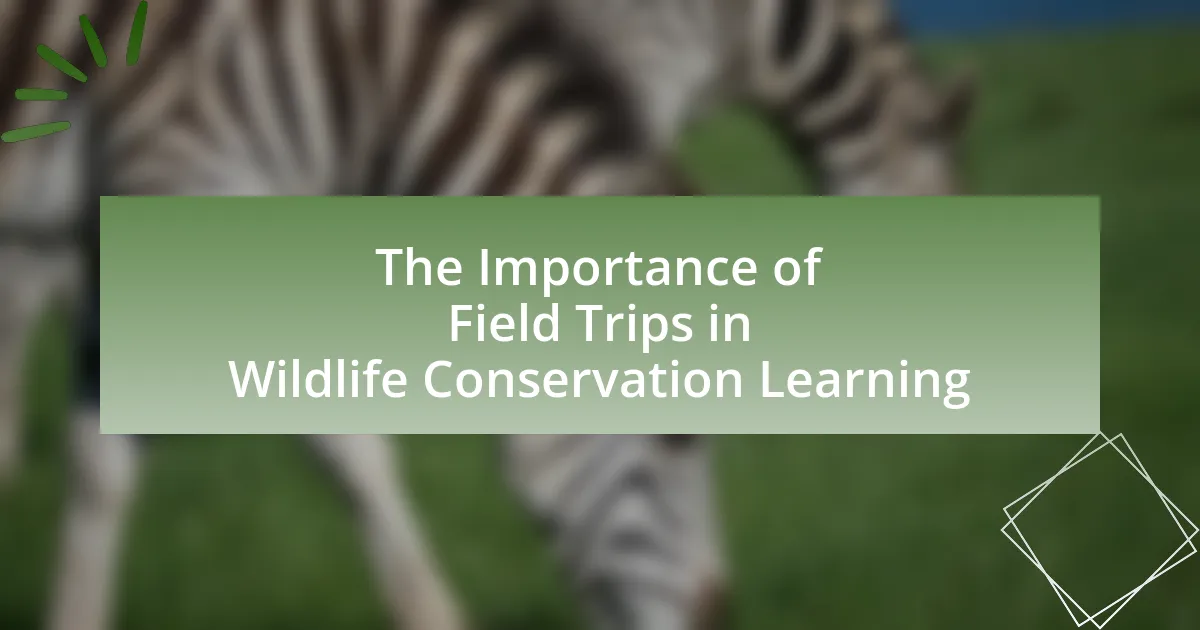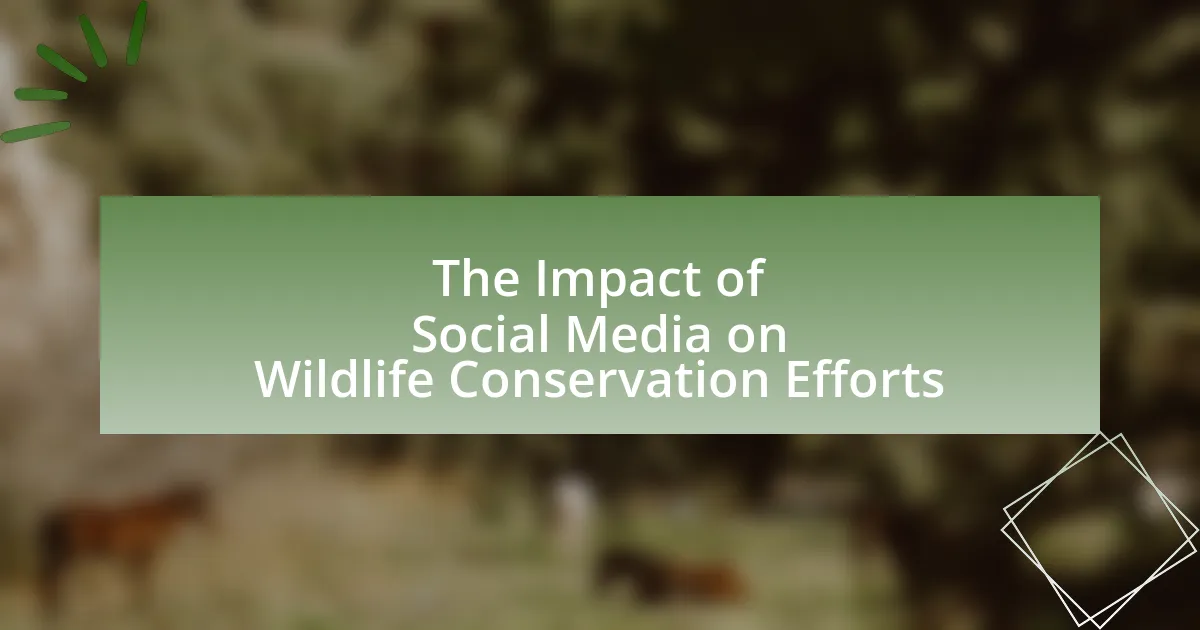Integrating Indigenous Knowledge into Wildlife Conservation Education focuses on incorporating traditional ecological knowledge and cultural practices of Indigenous peoples into conservation strategies and educational programs. This approach highlights the effectiveness of Indigenous land management techniques, such as controlled burns, in enhancing biodiversity and reducing wildfire risks. Key principles include holistic understanding, intergenerational knowledge transfer, and community involvement, which contrast with Western scientific methods. The article also addresses the challenges of integration, such as differing worldviews and communication barriers, while emphasizing the importance of collaboration between Indigenous communities and conservationists to improve educational outcomes and conservation efforts.
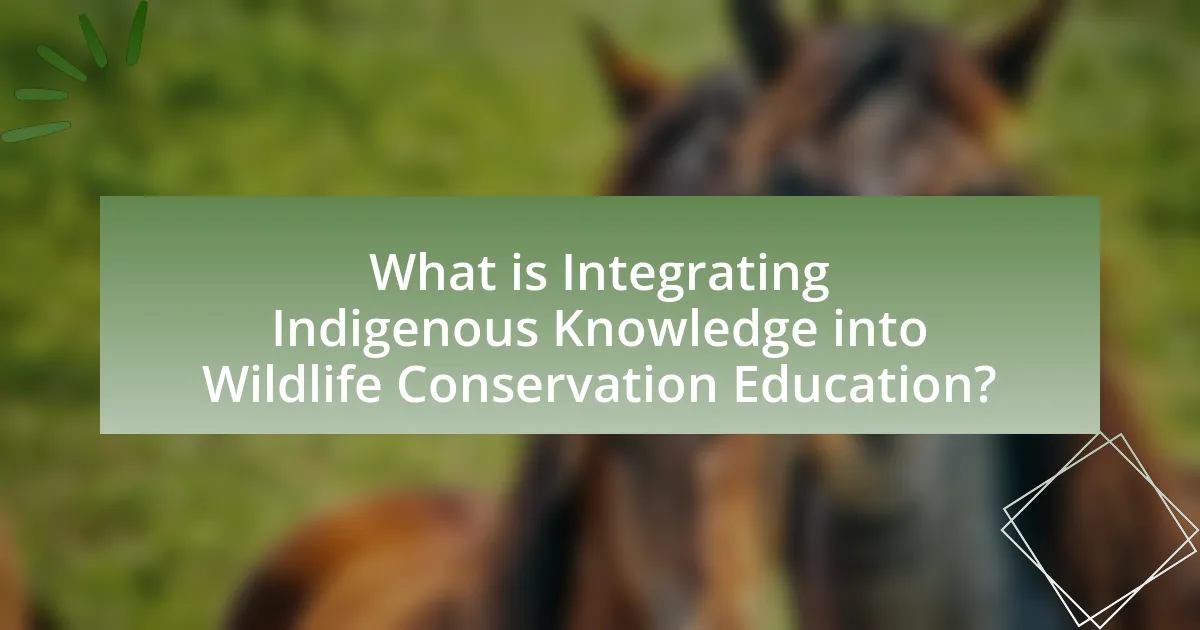
What is Integrating Indigenous Knowledge into Wildlife Conservation Education?
Integrating Indigenous Knowledge into Wildlife Conservation Education involves incorporating traditional ecological knowledge and cultural practices of Indigenous peoples into conservation strategies and educational programs. This approach recognizes the value of Indigenous perspectives in understanding ecosystems, biodiversity, and sustainable practices, which have been developed over generations. For instance, studies have shown that Indigenous land management techniques, such as controlled burns, can enhance biodiversity and reduce wildfire risks, demonstrating the effectiveness of these traditional methods in contemporary conservation efforts.
How does Indigenous Knowledge contribute to wildlife conservation?
Indigenous Knowledge contributes to wildlife conservation by providing a deep understanding of local ecosystems and sustainable practices developed over generations. This knowledge includes traditional ecological practices, species behavior, and habitat management techniques that are often more effective than modern methods. For instance, Indigenous communities have successfully managed resources through practices such as controlled burns to promote biodiversity and prevent wildfires, as evidenced by the use of fire management in Australia by Aboriginal peoples. Additionally, Indigenous Knowledge emphasizes the interconnectedness of species and their habitats, fostering a holistic approach to conservation that considers cultural, spiritual, and ecological dimensions. This integration of Indigenous perspectives has been shown to enhance conservation outcomes, as highlighted in studies like the one published in “Conservation Biology” by Berkes and Folke, which discusses the effectiveness of traditional knowledge in managing natural resources sustainably.
What are the key principles of Indigenous Knowledge in conservation?
The key principles of Indigenous Knowledge in conservation include holistic understanding, intergenerational knowledge transfer, and community involvement. Holistic understanding emphasizes the interconnectedness of ecosystems, recognizing that all elements of nature are interrelated and must be considered in conservation efforts. Intergenerational knowledge transfer ensures that traditional ecological practices and insights are passed down through generations, preserving valuable information about local biodiversity and sustainable practices. Community involvement highlights the importance of engaging Indigenous communities in decision-making processes, as their lived experiences and cultural practices contribute significantly to effective conservation strategies. These principles are supported by numerous case studies demonstrating the success of Indigenous-led conservation initiatives, which often result in improved biodiversity outcomes and enhanced community resilience.
How does Indigenous Knowledge differ from Western scientific approaches?
Indigenous Knowledge differs from Western scientific approaches primarily in its holistic and experiential nature, emphasizing relationships with the environment over empirical data. Indigenous Knowledge is often rooted in cultural traditions, oral histories, and a deep understanding of local ecosystems, which contrasts with Western science’s reliance on quantitative methods, controlled experiments, and reproducibility. For example, Indigenous communities may use traditional ecological knowledge to manage resources sustainably based on centuries of observation and interaction with their environment, while Western science typically seeks to isolate variables and apply standardized methodologies. This fundamental difference highlights the value of diverse perspectives in wildlife conservation education, as integrating both approaches can lead to more effective and culturally relevant conservation strategies.
Why is it important to integrate Indigenous Knowledge into conservation education?
Integrating Indigenous Knowledge into conservation education is crucial because it enhances ecological understanding and promotes sustainable practices rooted in centuries of experience. Indigenous communities possess unique insights into local ecosystems, biodiversity, and resource management, which can inform and improve contemporary conservation strategies. For instance, studies have shown that Indigenous land management practices, such as controlled burns, can significantly reduce wildfire risks and promote biodiversity, as evidenced by research from the Australian Institute of Aboriginal and Torres Strait Islander Studies. By incorporating these traditional practices and perspectives, conservation education becomes more holistic and effective, fostering a deeper connection between people and the environment.
What benefits does this integration provide for wildlife conservation efforts?
Integrating Indigenous knowledge into wildlife conservation efforts enhances biodiversity preservation and fosters sustainable practices. This integration allows for the incorporation of traditional ecological knowledge, which has been developed over generations and is often more attuned to local ecosystems than contemporary scientific approaches. For instance, Indigenous communities have historically managed land and wildlife in ways that promote ecological balance, as evidenced by practices such as controlled burns that prevent wildfires and support habitat regeneration. Furthermore, studies indicate that Indigenous-led conservation initiatives can lead to improved outcomes for species recovery and habitat restoration, as seen in the successful management of marine resources in Indigenous territories.
How does it enhance the educational experience for learners?
Integrating Indigenous knowledge into wildlife conservation education enhances the educational experience for learners by providing diverse perspectives and culturally relevant context. This approach fosters a deeper understanding of ecological relationships and promotes respect for traditional ecological knowledge, which has been developed over generations. Research indicates that incorporating Indigenous perspectives can lead to improved engagement and retention of information among students, as it connects them to local environments and communities. For instance, studies show that students exposed to Indigenous knowledge frameworks demonstrate increased critical thinking skills and a greater appreciation for biodiversity, ultimately enriching their overall learning experience.
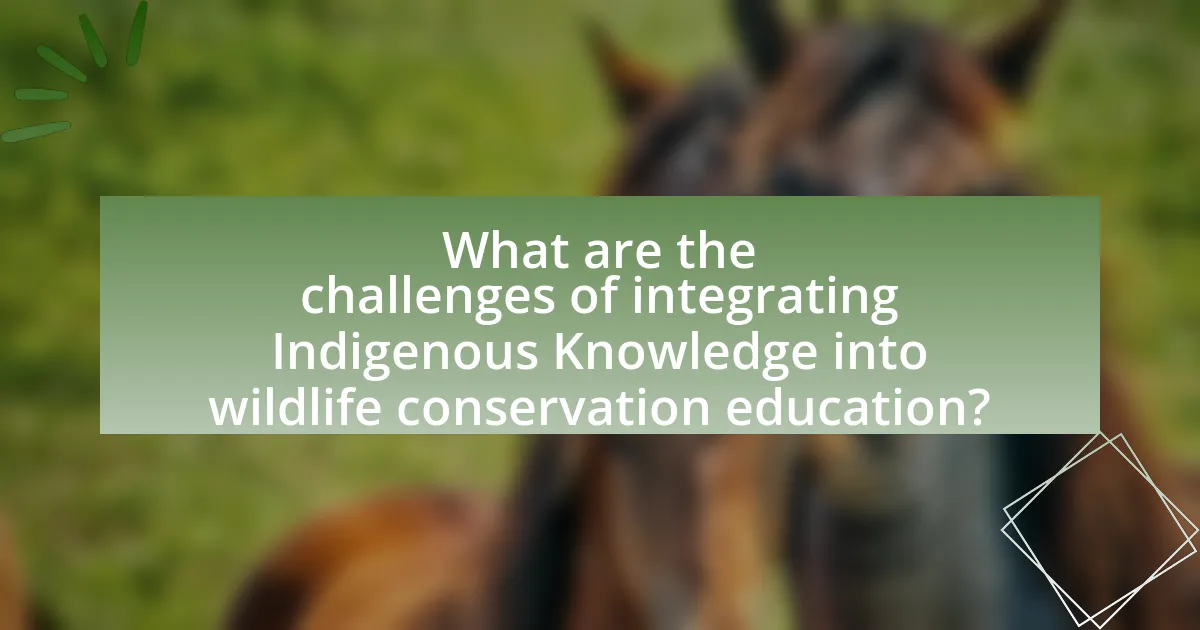
What are the challenges of integrating Indigenous Knowledge into wildlife conservation education?
Integrating Indigenous Knowledge into wildlife conservation education faces several challenges, primarily stemming from differing worldviews and communication barriers. Indigenous Knowledge often emphasizes holistic and relational understandings of nature, which can conflict with the reductionist approaches commonly used in Western scientific education. Additionally, there is often a lack of recognition and respect for Indigenous Knowledge systems within formal educational frameworks, leading to marginalization of these perspectives. Furthermore, the historical context of colonization has created mistrust between Indigenous communities and educational institutions, complicating collaboration efforts. These challenges hinder effective integration and limit the potential benefits of combining Indigenous Knowledge with contemporary conservation strategies.
What barriers exist in the collaboration between Indigenous communities and conservationists?
Barriers in the collaboration between Indigenous communities and conservationists include differing worldviews, lack of trust, and inadequate representation. Indigenous communities often prioritize cultural and spiritual connections to land, while conservationists may focus on ecological metrics, leading to conflicting objectives. Historical injustices and marginalization have resulted in a lack of trust towards conservation organizations, which can hinder effective partnerships. Additionally, Indigenous voices are frequently underrepresented in decision-making processes, limiting their influence on conservation strategies. These factors collectively impede meaningful collaboration and the integration of Indigenous knowledge into wildlife conservation education.
How can cultural misunderstandings impact conservation efforts?
Cultural misunderstandings can significantly hinder conservation efforts by creating conflicts between conservation strategies and local community practices. For instance, when conservation initiatives fail to consider Indigenous knowledge and cultural values, they may be perceived as top-down impositions, leading to resistance from local populations. A study by Davis and Slobodkin (2004) highlights that conservation programs that do not engage with local cultural contexts often result in ineffective management and loss of biodiversity, as communities may not support or participate in these initiatives. Therefore, recognizing and integrating cultural perspectives is essential for fostering collaboration and ensuring the success of conservation efforts.
What legal and ethical considerations must be addressed?
Legal and ethical considerations in integrating Indigenous knowledge into wildlife conservation education include the need for informed consent, respect for intellectual property rights, and recognition of cultural significance. Informed consent ensures that Indigenous communities are fully aware of how their knowledge will be used and that they agree to its application in conservation efforts. Respect for intellectual property rights is crucial, as Indigenous knowledge is often collective and tied to cultural heritage, requiring acknowledgment and protection against unauthorized use. Additionally, recognizing the cultural significance of Indigenous practices and beliefs fosters collaboration and mutual respect, which is essential for effective conservation strategies. These considerations are supported by frameworks such as the United Nations Declaration on the Rights of Indigenous Peoples, which emphasizes the importance of Indigenous rights in environmental governance.
How can these challenges be overcome?
To overcome the challenges of integrating Indigenous knowledge into wildlife conservation education, collaborative partnerships between Indigenous communities and educational institutions must be established. These partnerships can facilitate the sharing of traditional ecological knowledge, which has been shown to enhance biodiversity conservation efforts. For instance, research by Berkes (2012) highlights that Indigenous practices often lead to sustainable resource management, demonstrating the effectiveness of integrating these perspectives into formal education. Additionally, incorporating Indigenous voices in curriculum development ensures that educational content is culturally relevant and respectful, fostering a more inclusive learning environment.
What strategies can be implemented to foster collaboration?
To foster collaboration in integrating Indigenous knowledge into wildlife conservation education, establishing partnerships between Indigenous communities and educational institutions is essential. These partnerships can facilitate knowledge exchange, ensuring that Indigenous perspectives are respected and incorporated into conservation practices. Research indicates that collaborative approaches, such as co-management of resources, enhance the effectiveness of conservation efforts by leveraging local knowledge and fostering mutual respect (Berkes, 2009, “Evolution of Co-Management: Role of Knowledge Generation and Sharing”). Additionally, creating inclusive platforms for dialogue, such as workshops and community forums, encourages active participation from all stakeholders, leading to more comprehensive and culturally relevant conservation strategies.
How can educational programs be designed to respect Indigenous Knowledge?
Educational programs can be designed to respect Indigenous Knowledge by incorporating Indigenous perspectives, methodologies, and community involvement into the curriculum. This approach ensures that the educational content is relevant and reflective of Indigenous worldviews, which often emphasize a deep connection to the land and ecosystems.
For instance, programs can include collaboration with Indigenous elders and knowledge keepers to co-create learning materials that accurately represent Indigenous practices and beliefs. Research indicates that integrating Indigenous Knowledge in educational settings enhances cultural understanding and promotes biodiversity conservation, as seen in studies like “Indigenous Knowledge and Biodiversity Conservation” by Berkes et al. (2000), which highlights the effectiveness of traditional ecological knowledge in managing natural resources sustainably.
Furthermore, educational institutions can provide training for educators on the importance of Indigenous Knowledge, fostering an environment of respect and understanding. This multifaceted approach not only honors Indigenous cultures but also enriches the educational experience for all students.
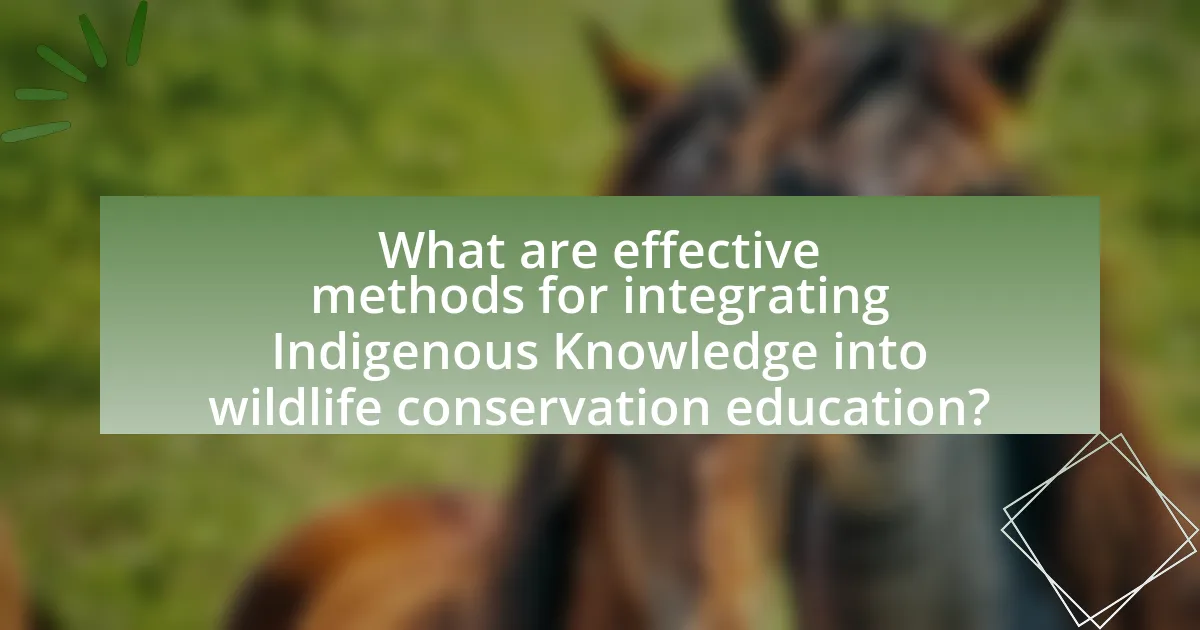
What are effective methods for integrating Indigenous Knowledge into wildlife conservation education?
Effective methods for integrating Indigenous Knowledge into wildlife conservation education include collaborative partnerships with Indigenous communities, incorporation of traditional ecological knowledge (TEK) into curricula, and experiential learning opportunities that involve Indigenous practices. Collaborative partnerships ensure that Indigenous voices are included in decision-making processes, fostering mutual respect and understanding. Incorporating TEK into educational materials provides students with insights into sustainable practices that have been honed over generations. Experiential learning, such as field trips or workshops led by Indigenous elders, allows students to engage directly with traditional practices, enhancing their understanding of the cultural significance of wildlife conservation. These methods have been shown to improve educational outcomes and promote biodiversity conservation by bridging scientific and Indigenous perspectives.
What role do community partnerships play in this integration?
Community partnerships play a crucial role in integrating Indigenous knowledge into wildlife conservation education by facilitating collaboration between Indigenous communities and conservation organizations. These partnerships enable the sharing of traditional ecological knowledge, which enhances conservation strategies and promotes sustainable practices. For instance, studies have shown that Indigenous land management practices can lead to improved biodiversity outcomes, as seen in various regions where Indigenous stewardship has been linked to healthier ecosystems. By working together, community partnerships ensure that conservation efforts are culturally relevant and effective, ultimately benefiting both wildlife and Indigenous communities.
How can local Indigenous leaders contribute to educational programs?
Local Indigenous leaders can contribute to educational programs by integrating traditional ecological knowledge into the curriculum. This knowledge encompasses sustainable practices and cultural perspectives that have been developed over generations, providing valuable insights into wildlife conservation. For instance, research has shown that Indigenous land management practices, such as controlled burns, enhance biodiversity and ecosystem health. By collaborating with educational institutions, Indigenous leaders can ensure that these practices are recognized and taught, fostering a deeper understanding of the relationship between culture and conservation among students.
What examples exist of successful partnerships in conservation education?
Successful partnerships in conservation education include collaborations between Indigenous communities and educational institutions, such as the partnership between the University of Alberta and the Kainai Nation. This partnership focuses on integrating Indigenous knowledge into wildlife conservation curricula, enhancing both academic learning and cultural preservation. Another example is the collaboration between the National Park Service and various Indigenous tribes in the United States, which aims to incorporate traditional ecological knowledge into park management and educational programs. These partnerships demonstrate effective strategies for combining scientific and Indigenous perspectives, leading to more holistic conservation education approaches.
How can curricula be developed to include Indigenous perspectives?
Curricula can be developed to include Indigenous perspectives by actively collaborating with Indigenous communities to integrate their knowledge systems, cultural practices, and values into educational frameworks. This approach ensures that Indigenous voices are represented and respected, fostering a more inclusive learning environment. For instance, the incorporation of traditional ecological knowledge (TEK) can enhance wildlife conservation education by providing insights into sustainable practices that have been used for generations. Research indicates that integrating TEK not only enriches scientific understanding but also promotes biodiversity conservation, as evidenced by studies showing improved ecosystem management outcomes in areas where Indigenous practices are applied.
What topics should be prioritized in educational materials?
Educational materials should prioritize the integration of Indigenous knowledge systems in wildlife conservation education. This approach acknowledges the historical and cultural significance of Indigenous practices, which have been proven to enhance biodiversity conservation efforts. Research indicates that Indigenous communities possess unique ecological insights and sustainable management practices that can complement scientific approaches, leading to more effective conservation outcomes. For instance, studies have shown that areas managed by Indigenous peoples often exhibit higher levels of biodiversity compared to those under conventional management. Therefore, focusing on Indigenous knowledge not only enriches educational content but also fosters respect for cultural diversity and promotes collaborative conservation strategies.
How can educators be trained to effectively teach Indigenous Knowledge?
Educators can be trained to effectively teach Indigenous Knowledge by engaging in collaborative partnerships with Indigenous communities and incorporating culturally relevant pedagogies. This approach ensures that educators gain authentic insights into Indigenous perspectives and practices, which are essential for teaching this knowledge accurately. Research indicates that programs like the “Indigenous Teacher Education Program” at the University of British Columbia emphasize experiential learning and community involvement, allowing educators to immerse themselves in Indigenous cultures and traditions. Such training fosters respect and understanding, enabling educators to convey Indigenous Knowledge in a manner that honors its significance and context within wildlife conservation education.
What practical steps can educators take to implement these methods?
Educators can implement methods for integrating Indigenous knowledge into wildlife conservation education by collaborating with Indigenous communities to co-develop curricula that reflect local ecological practices and cultural values. This collaboration ensures that the content is relevant and respectful, fostering a deeper understanding of Indigenous perspectives on conservation.
Additionally, educators should incorporate experiential learning opportunities, such as field trips to Indigenous-managed lands, where students can engage directly with traditional ecological knowledge. Research indicates that experiential learning enhances retention and appreciation of conservation principles (Kolb, 1984).
Furthermore, educators can provide professional development workshops focused on Indigenous knowledge systems, equipping teachers with the tools to effectively integrate these perspectives into their teaching. Studies show that teacher training in culturally responsive pedagogy leads to improved student engagement and learning outcomes (Gay, 2010).
By taking these practical steps, educators can create a more inclusive and effective wildlife conservation education framework that honors Indigenous knowledge.
What resources are available for educators looking to integrate Indigenous Knowledge?
Educators looking to integrate Indigenous Knowledge can access various resources, including curriculum guides, online databases, and community partnerships. For instance, the “Indigenous Knowledge Curriculum Framework” provides structured guidance for incorporating Indigenous perspectives into educational settings. Additionally, platforms like the “National Museum of the American Indian” offer digital resources and lesson plans that highlight Indigenous cultures and practices. Collaborating with local Indigenous communities can also enhance the educational experience by providing firsthand knowledge and context. These resources are essential for fostering a comprehensive understanding of Indigenous Knowledge in wildlife conservation education.
How can educators assess the effectiveness of their integration efforts?
Educators can assess the effectiveness of their integration efforts by utilizing a combination of qualitative and quantitative evaluation methods. These methods include pre- and post-assessments to measure knowledge gains, student feedback surveys to gauge engagement and understanding, and observational assessments to evaluate student participation and application of Indigenous knowledge in wildlife conservation contexts. Research indicates that integrating Indigenous perspectives can enhance student learning outcomes, as evidenced by studies showing improved retention of information and increased cultural awareness among students when Indigenous knowledge is included in curricula.
